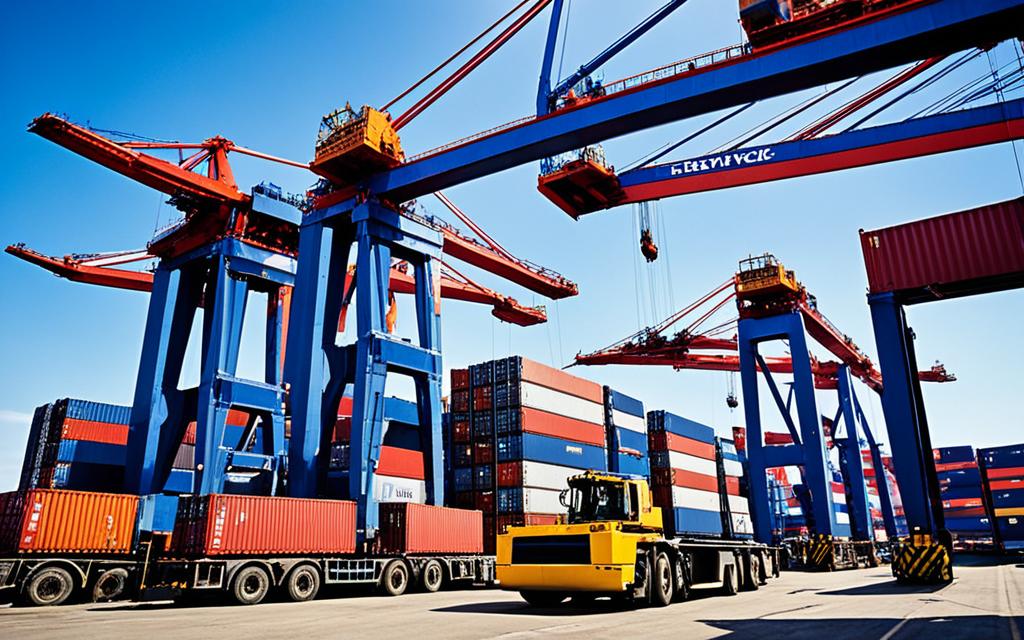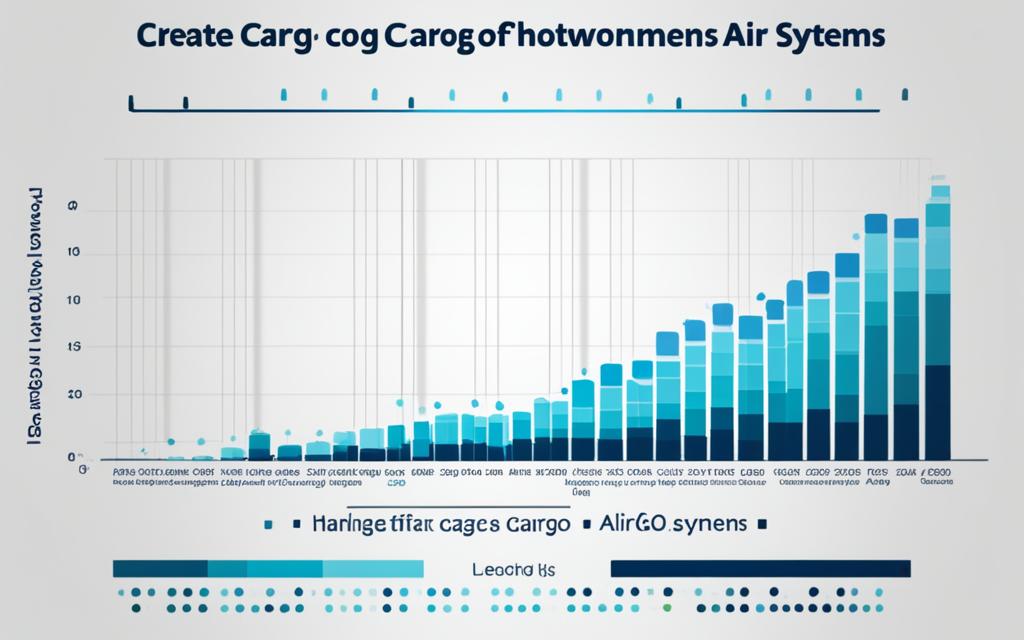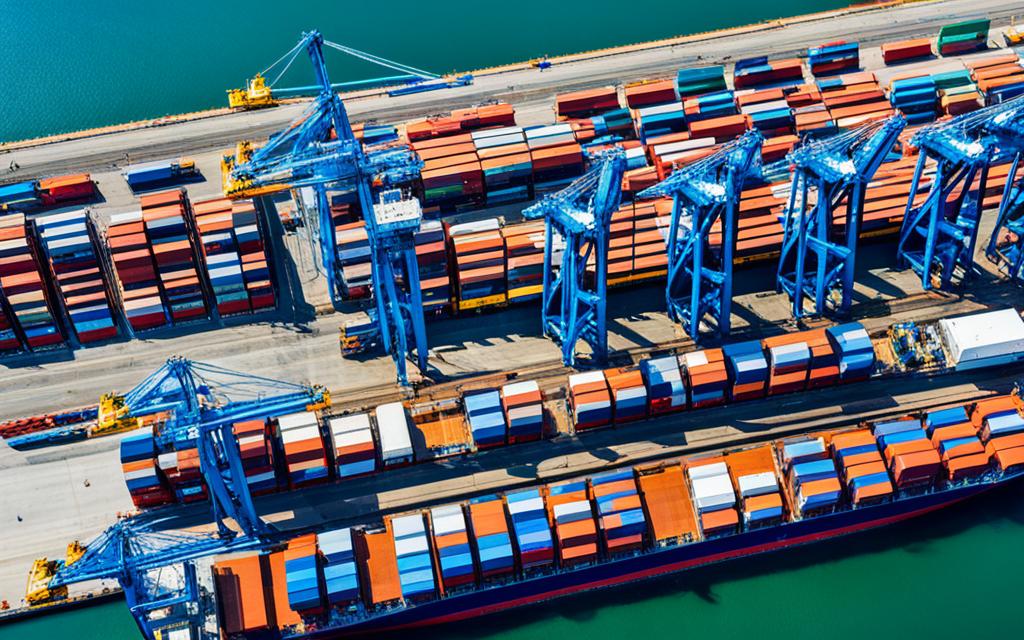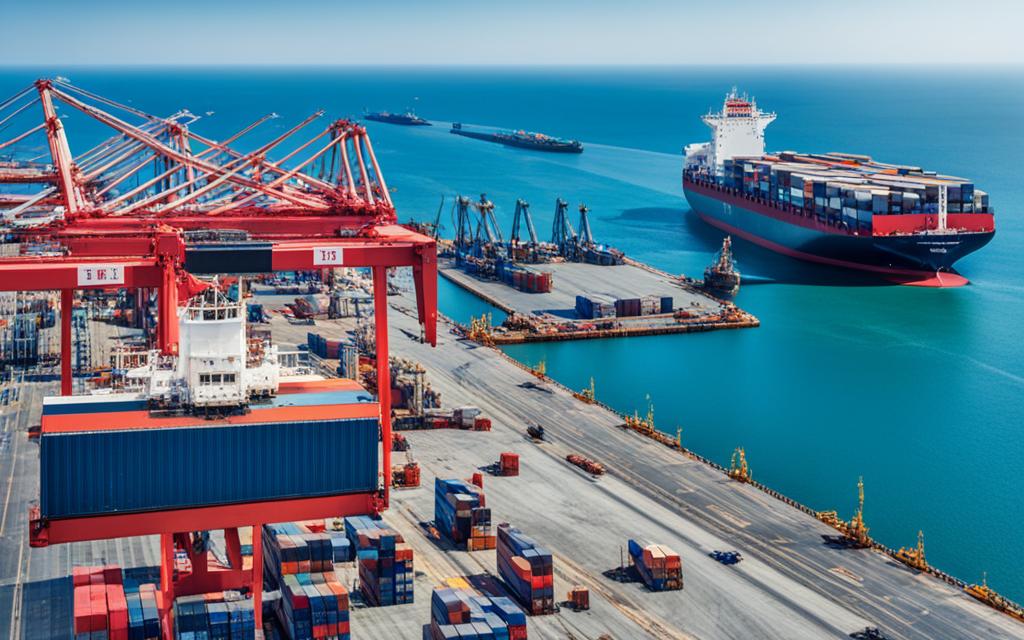
Efficiency Analysis Of Industrial Cargo Handling Systems
The efficiency analysis of industrial cargo handling systems is essential in optimizing operations and improving productivity.
This explores the various aspects of efficiency analysis in industrial cargo handling systems, including air cargo handling systems and container terminals.
By understanding the factors influencing efficiency and implementing strategies for improvement, businesses can enhance their operational performance and gain a competitive edge in the global trade market.
Key Takeaways:
- Efficiency analysis is crucial in optimizing operations and increasing productivity in industrial cargo handling systems.
- Technological advancements, infrastructure quality, and efficient operation management are key factors influencing efficiency in these systems.
- Investing in modern equipment, upgrading infrastructure, and implementing efficient maintenance practices can improve performance in container terminals.
- Collaboration among government authorities, port operators, and terminal managers is crucial for implementing strategies effectively.
- Enhancing efficiency in industrial cargo handling systems can reduce logistics costs and increase competitiveness in the global trade market.
Market Segmentation Of Air Cargo Handling Systems
Various components contribute to the industry’s growth and efficiency in the air cargo handling system market.
Some of the key players in this market include AMOVA GmbH, Pteris Global CIMC Group, Siemens, Lodige Industries Group, Doosan Forklifts, Adept Conveyor Technologies, Hermes Logistics Technologies Ltd., LUG air cargo handling GmbH, SACO Airport Equipment, McGrath Industries Ltd., Efficiency Systems Inc., ACS Advanced Cargo Handling Systems, and BDP Solutions LTD.
These companies specialize in providing innovative solutions for efficiently handling air cargo.
They offer a wide range of products and services that cater to the diverse needs of the market.
Furthermore, the market analysis includes segmenting air cargo handling systems based on their types.
The two main categories are semi-automated systems and fully automated systems.
Each type has its own unique characteristics and benefits, providing options for different operational requirements.
The market segmentation also extends to the application of air cargo handling systems.
Various sectors, including passenger airlines, cargo companies, and others, utilize these systems.
This diverse range of applications showcases the versatility and relevance of air cargo handling systems in the aviation industry.
By understanding the market segmentation of air cargo handling systems, industry players can better identify their target audience and tailor their products and services to meet specific needs.
This strategic approach contributes to the overall growth and success of the air cargo handling system market.
Key Drivers And Barriers In The Air Cargo Handling System Market
When it comes to the air cargo handling system market, several key drivers are propelling its growth.
First and foremost is the increasing demand for fast and efficient cargo handling services.
As globalization continues to thrive, businesses rely on the timely and reliable transportation of goods to meet customer demands.
Moreover, the rise of e-commerce and online shopping has fueled the need for efficient air cargo handling systems which use brushless DC motors.
With the exponential growth of online retail, companies require streamlined operations to fulfill online orders and deliver products to customers swiftly and accurately.
Advancements in technology have also played a crucial role in driving the air cargo handling system market.
Automation and robotics have revolutionized the industry by enhancing operational efficiency and reducing manual labor.
This not only improves overall effectiveness but also enables cost savings for cargo-handling companies.
However, despite these key drivers, the market faces various barriers to overcome.
Stringent regulations and security measures pose challenges for air cargo handlers.
Compliance with these regulations can be costly and time-consuming, adding additional complexities to already demanding operations.
Another significant barrier in the air cargo handling system market is the high initial investments required for infrastructure and equipment.
Establishing efficient cargo handling facilities and acquiring state-of-the-art equipment demands substantial financial resources, making it difficult for some companies to enter the market.
Furthermore, the limited space and capacity at airports present challenges for expanding air cargo operations.
The growing demand for air cargo services has strained existing infrastructure, making airports need to invest in expansion projects to meet the increasing cargo volumes.
In addition to these barriers, the market faces intense competition among cargo handling companies.
Numerous players vying for market share make the competition fierce.
This drives companies to innovate and differentiate themselves to stay ahead continuously.
Fluctuating fuel prices also impact cargo handling companies’ operating costs.
Fuel costs are one of the industry’s major expenses and directly affect profitability.
To mitigate this challenge, companies must carefully manage their fuel consumption and explore alternative energy sources.
Lastly, the need for continuous investment in technology and automation presents an ongoing challenge for the air cargo handling system market.
To remain competitive, companies must keep up with technological advancements and implement automation solutions that improve efficiency and reduce costs.
Key drivers in the air cargo handling system market include the increasing demand for fast and efficient cargo handling services, growth in e-commerce and online shopping, and advancements in technology that enhance operational efficiency.
Barriers to the market include stringent regulations and security measures, high initial investments for infrastructure and equipment, and limited space and capacity at airports.
Challenges in the market include intense competition among cargo handling companies, fluctuating fuel prices impacting operating costs, and the need for continuous investment in technology and automation to stay competitive.
Overcoming these barriers and challenges is crucial for the growth and success of the air cargo handling system market.
By addressing these issues and leveraging the key drivers, cargo-handling companies can position themselves to meet the growing demand for efficient and reliable air cargo services.
Air Cargo Handling System Market Statistics:

These statistics provide a visual representation of the key drivers and barriers in the air cargo handling system market.
Competitive Landscape In The Air Cargo Handling System Market
In the competitive air cargo handling system market, several key players have emerged, each offering innovative solutions to meet the growing demand for efficiency and reliability.
One such player is Siemens, a well-known German multinational conglomerate company.
Siemens specializes in providing state-of-the-art automation and control solutions that optimize the operations of airports and logistics companies, ultimately increasing their efficiency.
With a strong technological foundation, Siemens is at the forefront of driving advancements in the air cargo handling system market.
Another major player in the market is Pteris Global CIMC Group, which offers integrated and customized cargo handling solutions.
With its comprehensive range of services, Pteris Global CIMC Group caters to the unique requirements of customers in the air cargo industry, ensuring smooth and seamless handling of goods throughout the supply chain.
Efficiency Systems Inc. is another prominent player in the air cargo handling system market.
The company specializes in designing and manufacturing advanced material handling equipment, providing cutting-edge solutions that optimize cargo handling processes.
These key players are well-positioned to capitalize on the growing demand for efficient and reliable air cargo handling solutions.
By continually innovating and delivering high-quality products and services, they contribute significantly to the competitive landscape of the air cargo handling system market.
Importance Of Container Ports In International Trade
Container ports play a pivotal role in international trade, facilitating the movement of goods and fostering economic development.
These ports serve as crucial hubs where shipments are received, processed, and dispatched to various destinations worldwide.
With the increasing global trade volume, efficient container ports are essential for smooth supply chain operations.
One example of such growth can be seen in Vietnam, where container throughput has experienced significant expansion in recent years.
From 2010 to 2017, Vietnam’s container throughput achieved a compound growth rate of 10.9%.
This growth reflects the country’s increasing participation in international trade and highlights the importance of container ports in supporting economic growth.

However, container ports in lower-middle-income (LMI) countries face unique challenges related to terminal location, transshipment and handling equipment, and operation management.
These challenges can hinder the efficiency and effectiveness of container ports, impacting the flow of goods and the competitiveness of countries in the global trade market.
Improving port efficiency is crucial for reducing logistics costs and enhancing the performance of container ports in LMI countries.
By implementing advanced technologies, optimizing operational processes, and investing in infrastructure, these ports can overcome their challenges and meet the demands of international trade.
Efficient container ports contribute to lower shipping costs, faster delivery times, and enhanced reliability in supply chains.
They enable businesses to access global markets more effectively and promote economic growth by attracting foreign investments and fostering trade partnerships between nations.
“Container ports are the gateways to international trade, facilitating the movement of goods and driving economic development.”
Benefits Of Efficient Container Ports In International Trade
- Reduced logistics costs: Efficient container ports optimize operations, leading to cost savings in transportation, handling, and storage. This translates into more affordable prices for goods and services.
- Enhanced global competitiveness: Countries with efficient container ports gain a competitive edge in the global trade market, attracting investments and boosting trade partnerships.
- Faster delivery times: Efficient container ports streamline processes, resulting in faster delivery of goods and improved customer satisfaction.
- Reliable supply chains: Efficient container ports minimize delays and disruptions in supply chains, ensuring a steady flow of goods to meet market demand.
- Environmental sustainability: Efficient container ports can adopt greener practices, reducing carbon emissions and promoting sustainability in global trade.
Overall, container ports are vital in facilitating international trade and driving economic growth.
By addressing challenges and improving efficiency, these ports can contribute to seamless global supply chains and foster prosperous trade relationships between nations.
Assessing The Efficiency Of Container Ports In LMI Countries
The efficiency assessment of container ports in lower-middle-income (LMI) countries plays a significant role in optimizing their operations and enhancing their competitiveness in the global trade market.
Data envelopment analysis (DEA) is a commonly used technique to measure the efficiency of container ports in LMI countries.
DEA considers multiple inputs and outputs to evaluate the overall efficiency of container ports.
When assessing the efficiency of container ports in LMI countries, it is important to distinguish between pure technical inefficiency and scale inefficiency.
Pure technical inefficiency refers to suboptimal utilization of inputs, such as labor and infrastructure, while scale inefficiency relates to operating at an inappropriate scale.
“The overall technical inefficiency of container ports in LMI countries is predominantly due to pure technical inefficiency rather than scale inefficiencies. This suggests that improving input utilization and operational processes can significantly enhance the efficiency of container ports in these countries.”
Interestingly, the size of a container port, measured by throughput, does not necessarily correlate with its efficiency.
While larger ports may have advantages in economies of scale, smaller ports with a focused production scale can also achieve high efficiency levels.
The most efficient container ports in LMI countries often have a combination of large and hub ports, which allows for the effective handling of diverse cargo volumes and types.
Efficiency assessment of container ports is essential for LMI countries to identify areas for improvement and implement targeted strategies that enhance their operational performance.
By addressing specific inefficiencies identified through DEA, these countries can optimize their resource allocation, improve infrastructure utilization, and streamline operational processes.
Factors Influencing Port Efficiency In LMI Countries
Efficient port operations facilitate international trade and economic development in lower-middle-income (LMI) countries.
However, several factors can influence the efficiency of container ports in these regions.
Firstly, infrastructure quality is a significant factor influencing port efficiency.
Well-maintained harbors, navigational channels, and berths ensure smooth vessel operations and minimize delays.
Inadequate infrastructure poses challenges and hampers the timely movement of goods, impacting overall port efficiency.
Logistics performance also plays a vital role in port efficiency.
Efficient customs processes, streamlined administrative procedures, and integrated supply chains contribute to faster cargo handling and reduced dwell time.
Collaboration between port authorities and logistics stakeholders is crucial to enhancing logistics performance and overall port efficiency.
Technological advancements have revolutionized the port industry and significantly impacted port efficiency.
Automation and digitalization enable efficient cargo tracking, real-time data sharing, and better coordination between various stakeholders.
Investing in modern handling equipment, such as automated cranes and storage systems, improves operational efficiency and reduces turnaround times.
“Technological advancements enable efficient cargo tracking, real-time data sharing,
and better coordination between various stakeholders.”
LMI countries often face challenges related to infrastructure and logistics, impacting port efficiency.
Limited financial resources, lack of expertise, and governmental regulations pose significant barriers.
However, investing in infrastructure development, adopting best practices, and implementing efficient operation management strategies can help overcome these challenges and enhance port efficiency in LMI countries.
To illustrate the significance of port efficiency, let’s consider an example: a container port in a lower-middle-income country experiencing congestion due to outdated handling equipment and insufficient infrastructure capacity.
Despite having a strategic location, the port struggles to meet the increasing demand, leading to delays and additional costs for importers and exporters.
By addressing these factors influencing port efficiency, such as upgrading equipment and expanding infrastructure, the port can improve turnaround times, reduce logistics costs, and attract more trade.”
By addressing infrastructure quality, logistics performance, and technological advancements, LMI countries can enhance the efficiency of their container ports.
This, in turn, will reduce logistics costs, facilitate smoother trade flows, and strengthen their competitiveness in the global market.

Performance Measurement Of Container Terminals In Vietnam
Various indicators can be used to measure the performance of container terminals in Vietnam.
These indicators provide valuable insights into the terminals’ efficiency and effectiveness, helping identify areas for improvement.
Key performance measurement metrics include container throughput, productivity, and overall equipment effectiveness (OEE).
Container throughput is a fundamental indicator that measures the volume of containers a terminal handles within a given period.
It reflects the terminal’s capacity and efficiency in handling cargo.
By analyzing container throughput data, terminal operators can assess their operational capabilities and identify potential bottlenecks or areas of congestion that may hinder performance.
Productivity, another important metric, assesses the efficiency of terminal operations.
It measures the output achieved per input unit, such as labor, equipment, and time.
Improving productivity directly impacts the terminal’s ability to handle more containers in a given timeframe, enhancing operational performance and customer satisfaction.
The overall equipment effectiveness (OEE) provides a comprehensive view of the availability, performance, and quality of equipment used in container terminals.
OEE considers factors such as equipment downtime, speed, and quality of operations.
By assessing OEE, terminal operators can identify underutilized or inefficient equipment, outdated technologies, or ineffective maintenance practices that may hinder overall terminal performance.
“Improving OEE can have a significant impact on the performance and operational efficiency of container terminals in Vietnam. By identifying and addressing issues related to outdated handling equipment and ineffective maintenance practices, terminals can enhance their throughput, productivity, and overall performance.”
Efficient container terminals are crucial in facilitating international trade, enabling the smooth movement of goods in and out of Vietnam.
By implementing effective performance measurement strategies and continuously striving for improvement, container terminals in Vietnam can optimize their operations, deliver better customer service, and enhance their competitiveness in the global trade market.
Strategies For Improving Container Terminal Performance In Vietnam
Implementing various strategies is crucial to enhancing container terminal performance in Vietnam.
By investing in modern handling equipment, upgrading infrastructure, implementing efficient maintenance practices, and optimizing operation management, container terminals can experience significant improvements.
These strategies aim to increase productivity, reduce downtime, and enhance overall performance.
Investing In Modern Handling Equipment
One key strategy for improving container terminal performance in Vietnam is to invest in modern handling equipment.
Upgrading to advanced technology such as automated cranes, forklifts, and container handling machinery can streamline operations, increase efficiency, and reduce manual labor.
Modern equipment enables faster container loading and unloading, minimizing turnaround time and improving overall terminal performance.
Upgrading Infrastructure
Another important aspect to consider when improving container terminal performance in Vietnam is upgrading the infrastructure.
Enhancing container yard capacity, improving road and rail connections, and implementing advanced IT systems can optimize container flow and increase operational efficiency.
Upgraded infrastructure allows for smoother operations, reduced congestion, and improved turnaround times, benefiting port operators and shippers.
Implementing Efficient Maintenance Practices
Efficient maintenance practices play a vital role in ensuring the smooth functioning of container terminals.
Regular inspections, preventive maintenance, and timely repairs help minimize equipment downtime and reduce the risk of unexpected breakdowns.
By implementing well-defined maintenance schedules and establishing a proactive maintenance culture, container terminals can maintain optimal performance levels and prevent costly operational disruptions.
“Efficient maintenance practices can significantly contribute to the overall operational efficiency and performance of container terminals in Vietnam.” – Industry Expert
Optimizing Operation Management
Optimizing operation management is a critical strategy for improving container terminal performance.
This includes implementing effective workflow processes, optimizing berth planning and scheduling, and utilizing advanced data analytics for real-time decision-making.
Efficient operation management helps reduce bottlenecks, streamline operations, and ensure optimal resource utilization, improving terminal performance and customer satisfaction.
Implementing these strategies, including investing in modern handling equipment, upgrading infrastructure, implementing efficient maintenance practices, and optimizing operation management, can significantly improve container terminal performance in Vietnam.
Collaboration among government authorities, port operators, and terminal managers is essential for successfully implementing these strategies and driving positive changes in the container terminal industry.
The efficiency analysis of container terminals and other industrial cargo handling systems is paramount to enhance operational efficiency and reduce logistics costs.
Technological advancements, high-quality infrastructure, and efficient operation management are key factors that significantly contribute to improving efficiency in these systems.
By implementing strategies such as investing in modern equipment and infrastructure, optimizing operations, and fostering innovation, container terminals can improve their efficiency, resulting in better performance and increased competitiveness in the global trade market.
